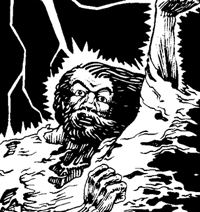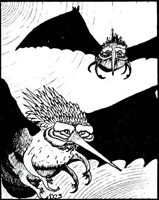 Cloud and storm giants are the most powerful of the standard races of giant in the D&D rules, the two final rungs on the ladder of increasing humanoid power. There doesn't seem to be any specific inspiration for them, although giants are sometimes associated with the sky in myths and legends. They are also the most intelligent, and the most inclined to be helpful, rather than hostile.
Cloud and storm giants are the most powerful of the standard races of giant in the D&D rules, the two final rungs on the ladder of increasing humanoid power. There doesn't seem to be any specific inspiration for them, although giants are sometimes associated with the sky in myths and legends. They are also the most intelligent, and the most inclined to be helpful, rather than hostile.Tuesday 27 April 2021
D&D Monsters: Cloud and Storm Giants
 Cloud and storm giants are the most powerful of the standard races of giant in the D&D rules, the two final rungs on the ladder of increasing humanoid power. There doesn't seem to be any specific inspiration for them, although giants are sometimes associated with the sky in myths and legends. They are also the most intelligent, and the most inclined to be helpful, rather than hostile.
Cloud and storm giants are the most powerful of the standard races of giant in the D&D rules, the two final rungs on the ladder of increasing humanoid power. There doesn't seem to be any specific inspiration for them, although giants are sometimes associated with the sky in myths and legends. They are also the most intelligent, and the most inclined to be helpful, rather than hostile.Tuesday 20 April 2021
D&D Monsters: Ettins
In any event, "ettin" is simply another, and older, word for "giant". In D&D, however, it specifically refers to a kind of two-headed giant; this is original to the game, but has been adopted by some other writers and computer game designers since.
Thursday 25 March 2021
D&D Monsters: Frost and Fire Giants
 Both frost and fire giants, as portrayed in D&D, are loosely based on the jötunn of Norse myth. In the original myths, this was a rather vague term referring to a race of mostly (but not always) gigantic beings originally created by the primordial being Ymir. Ymir himself was certainly gigantic, since the sky is said to be the inside of his blue-coloured skull, and he was also described in the Prose Edda as "ice cold". Thus, while frost giants aren't a specific thing in Norse myth, it's clear where the idea comes from. Fire giants, apparently also descended from Ymir in the original myth, are the inhabitants of the fiery realm of Muspelheim, led by Surtur, whose primary function in the myths is to destroy the world at the conclusion of Ragnarok.
Both frost and fire giants, as portrayed in D&D, are loosely based on the jötunn of Norse myth. In the original myths, this was a rather vague term referring to a race of mostly (but not always) gigantic beings originally created by the primordial being Ymir. Ymir himself was certainly gigantic, since the sky is said to be the inside of his blue-coloured skull, and he was also described in the Prose Edda as "ice cold". Thus, while frost giants aren't a specific thing in Norse myth, it's clear where the idea comes from. Fire giants, apparently also descended from Ymir in the original myth, are the inhabitants of the fiery realm of Muspelheim, led by Surtur, whose primary function in the myths is to destroy the world at the conclusion of Ragnarok.Both frost and fire giants appear in a range of fictional sources, of which perhaps the most obvious are the Mighty Thor comics. These predate D&D by over ten years, although it's likely that their appearance in the game is an independent creation from the same mythic origin, since they're quite clearly different from the comicbook versions. In D&D, they are the third and fourth rungs on the six-step ladder of increasing giant power and strength and are portrayed as more technologically advanced than the smaller hill and stone giants.
Wednesday 17 March 2021
D&D Monsters: Hill and Stone Giants
As is common where variants of the same idea for a monster exist in 1E, the six basic giants are arranged in a clear hierarchy of power, with each type having one extra hit dice, one extra point of strength, and delivering one extra die of damage than the one below it. Unlike some other creatures, while the details change, this progression of power remains the same in later editions.
Tuesday 23 February 2021
D&D Monsters: Bulettes

Incidentally, Gygax originally intended the word to be pronounced as "boo-lay", and official material from WoTC, and TSR before them, used to insist on this - and maybe still does. This raises a question, often seen in fantasy literature more generally, of "then why didn't you spell it that way?" In this case, I'll note that both the spelling and the supposed pronunciation appear vaguely French, which may be intentional - although, obviously, they don't match up with one another in that language either...
Sunday 31 January 2021
D&D Monsters: Stirges
 The strige is a creature of Roman myth, derived from the earlier Greek strix. It was said to be a nocturnal bird, albeit one that hung upside down like a bat, which drank the blood of infants and possibly even ate the remains. The Greek version of the name has since been adopted as a scientific name for a genus of owl, and, blood-drinking aside, the general description does seem to match owls more than anything else that might exist in the real world. The name later also became associated with witches and with a more humanoid form of vampire, the strigoi.
The strige is a creature of Roman myth, derived from the earlier Greek strix. It was said to be a nocturnal bird, albeit one that hung upside down like a bat, which drank the blood of infants and possibly even ate the remains. The Greek version of the name has since been adopted as a scientific name for a genus of owl, and, blood-drinking aside, the general description does seem to match owls more than anything else that might exist in the real world. The name later also became associated with witches and with a more humanoid form of vampire, the strigoi.
In D&D, of course, the name mutates again to the form "stirge". While it looks even less owl-like than the mythic creature, it's still clearly based on it... but is more inclined to attack adults than babies.
Friday 15 January 2021
D&D Monsters: Manticores
When the creature was adopted for D&D, however, Gygax made a major innovation to the mythic creature: he gave it wings. (At least, this is true by the 1E Monster Manual; the original version of the rules apparently doesn't mention the feature). Although this is original to the game, it has become a common trope of manticore pictures since, even outside of D&D, although it's far from universal.


